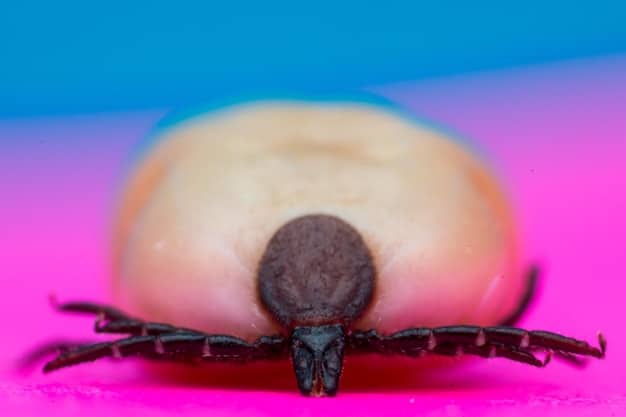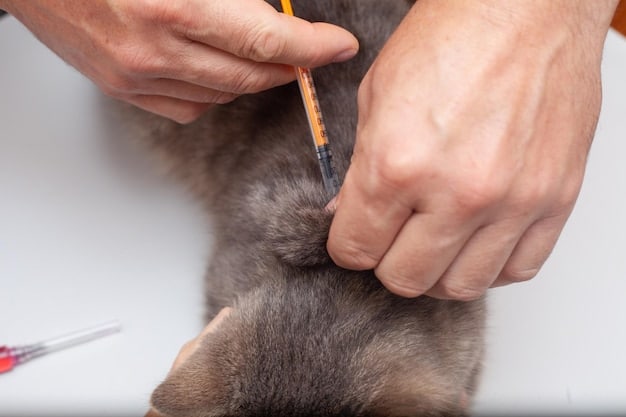Protect Your Pet: Lyme Disease Prevention Strategies for 2025

Protect your pet from Lyme disease in 2025 by employing updated tick prevention strategies, including regular tick checks, veterinarian-approved preventatives, and maintaining a tick-safe environment.
With warmer temperatures and increasing tick populations, protecting our beloved pets from Lyme disease is more crucial than ever. This article will delve into updated tick prevention strategies for 2025, ensuring your furry friends stay healthy and Lyme-free. Protect Your Pet From Lyme Disease: Updated Tick Prevention Strategies for 2025 involves a multi-faceted approach, from preventative medications to environmental control.
Understanding Lyme Disease in Pets
Lyme disease is a significant concern for pet owners, especially those living in or traveling to areas with high tick populations. Understanding the disease, how it affects pets, and the risks involved is the first step in effective prevention.
Lyme disease is caused by the bacterium *Borrelia burgdorferi*, which is transmitted through the bite of infected black-legged ticks, also known as deer ticks. These ticks are commonly found in grassy and wooded areas, making pets who enjoy outdoor activities particularly vulnerable.
How Lyme Disease Affects Pets
The symptoms of Lyme disease in pets can vary, and some animals may not show any signs at all. However, common symptoms include:
- Lameness: Often shifting and intermittent, affecting one or more legs.
- Joint pain and swelling.
- Fever.
- Lethargy.
- Loss of appetite.
In severe cases, Lyme disease can lead to kidney damage, which can be life-threatening. It’s crucial to recognize these symptoms and seek veterinary care promptly if you suspect your pet has been bitten by a tick.
Geographic Risks and Prevalence
Lyme disease is prevalent in certain regions of the United States, particularly the Northeast, Mid-Atlantic, and Upper Midwest. However, the geographic range of ticks is expanding due to climate change and other environmental factors, so it’s essential to be vigilant regardless of where you live.
To summarize, recognizing Lyme disease and its potential impact on your pet’s health is paramount. By understanding the disease, its symptoms, and its geographic distribution, you can take proactive steps to protect your furry companion.

Updated Tick Prevention Methods for 2025
Effective tick prevention is the cornerstone of protecting your pet from Lyme disease. As we approach 2025, several updated and advanced methods can help keep your pets safe. A combination of preventative medications, regular checks, and environmental controls can significantly reduce the risk of tick bites.
Here are some of the most effective strategies for preventing ticks from latching onto your pets and transmitting Lyme disease:
- Veterinarian-Approved Preventatives: There are several types of tick preventatives available, including topical treatments, oral medications, and tick collars. Discuss the best option for your pet with your veterinarian.
- Regular Tick Checks: Thoroughly check your pet for ticks after spending time outdoors, especially in grassy or wooded areas. Pay close attention to areas such as the ears, neck, armpits, and between the toes.
- Environmental Control: Keep your yard well-maintained by mowing the lawn regularly, removing leaf litter, and creating a barrier between your yard and wooded areas.
Choosing the Right Preventative
Selecting the right tick preventative can be overwhelming, with so many options available. Your veterinarian can help you choose the most effective product based on your pet’s lifestyle, health history, and geographic location.
Common types of tick preventatives include:
- Topical Treatments: Applied directly to the skin, these treatments typically contain insecticides that kill ticks on contact.
- Oral Medications: Chewable tablets that are given monthly, these medications work by killing ticks after they bite your pet.
- Tick Collars: These collars release a continuous dose of insecticide that repels and kills ticks.
Remember, not all tick preventatives are created equal. Some products may be more effective than others, and some may have potential side effects. Your veterinarian can help you weigh the pros and cons of each option.
Considering the various options for tick prevention, consulting your veterinarian is essential. They can provide guidance on the most suitable preventative based on individual needs and circumstances. By implementing a consistent and effective prevention strategy, you can significantly reduce the risk of Lyme disease and other tick-borne illnesses in your pet.
The Role of Tick Checks and Removal
Regular tick checks are a vital part of protecting your pet from Lyme disease. Even with preventative medications, it’s important to inspect your pet for ticks after spending time outdoors. Early detection and prompt removal can minimize the risk of Lyme disease transmission.
Following are key steps involved in conducting thorough tick checks and safely removing any attached ticks:
How to Perform a Tick Check
When checking your pet for ticks, use your fingers to feel for small bumps or irregularities on their skin. Pay close attention to areas where ticks are commonly found, such as:
- Ears
- Neck
- Armpits
- Between the toes
If you find a tick, use fine-tipped tweezers to grasp it as close to the skin as possible. Pull the tick straight out with a steady motion. Avoid twisting or jerking, as this can cause the tick’s mouthparts to break off and remain in the skin.
Safe Tick Removal Techniques
After removing a tick, clean the bite area with soap and water, and disinfect it with antiseptic. Dispose of the tick properly by placing it in a sealed bag or container and discarding it in the trash. You can also flush it down the toilet.
It’s important to monitor your pet for any signs of infection or illness after a tick bite. If you notice any redness, swelling, or discharge around the bite area, or if your pet develops a fever or lethargy, consult your veterinarian.
In summary, combining regular tick checks with proper removal techniques can greatly reduce the likelihood of Lyme disease transmission to your pet. Taking proactive measures to inspect your pet and safely remove any attached ticks is crucial for their well-being.

Creating a Tick-Safe Environment
Maintaining a tick-safe environment is an essential component of Lyme disease prevention. By reducing tick habitats in and around your yard, you can minimize the risk of exposure for your pets. This involves a combination of landscaping practices and preventative measures.
Creating a tick-safe environment involves:
- Mowing the lawn regularly: Keeping grass short reduces tick habitats.
- Removing leaf litter: Ticks thrive in moist, shady environments, so remove leaf litter and other debris.
- Creating a barrier: Use wood chips or gravel to create a barrier between your yard and wooded areas, discouraging ticks from entering your property.
Landscaping Tips for Tick Control
In addition to the above measures, consider incorporating tick-repelling plants into your landscaping. Some plants, such as lavender, rosemary, and mint, contain natural compounds that deter ticks. Planting these around the perimeter of your yard can help create a tick-resistant zone.
Natural Tick Repellents
There are several natural tick repellents available that can be used on your pets and in your yard. These repellents typically contain essential oils, such as cedarwood, eucalyptus, and lemongrass, which have been shown to repel ticks. However, it’s important to use these products with caution, as some essential oils can be toxic to pets if ingested.
Creating and maintaining a tick-safe environment is essential for minimizing the risk of Lyme disease transmission to your pets. By implementing landscaping practices, using natural tick repellents, and maintaining a clean yard, you can significantly reduce the number of ticks in your pet’s environment. This proactive approach contributes to their overall well-being and protects them from tick-borne illnesses.
Understanding Lyme Disease Vaccines
Vaccination is another tool in the arsenal against Lyme disease, offering an added layer of protection for pets at risk. Lyme disease vaccines work by stimulating the pet’s immune system to produce antibodies that fight the *Borrelia burgdorferi* bacteria. These vaccines can be particularly beneficial for pets living in high-risk areas or those with frequent exposure to ticks.
Understanding the efficacy, benefits, and potential side effects of vaccination helps pet owners make informed decisions. Let’s review some vital aspects of Lyme disease vaccines:
Efficacy and Benefits
Lyme disease vaccines have been shown to be effective in reducing the risk of infection in pets. However, it’s important to note that the vaccines are not 100% effective, and pets can still contract Lyme disease even if they have been vaccinated. Therefore, vaccination should be used in conjunction with other tick prevention measures, such as preventative medications and regular tick checks.
- Reduced risk of Lyme disease infection.
- Protection against severe symptoms and complications.
- Enhanced immune response to *Borrelia burgdorferi* bacteria.
Potential Side Effects and Considerations
Like all vaccines, Lyme disease vaccines can cause side effects in some pets. Common side effects include:
- Mild fever
- Lethargy
- Soreness at the injection site
These side effects are usually temporary and resolve within a few days. In rare cases, pets may experience more serious side effects, such as allergic reactions. Discuss the potential risks and benefits of vaccination with your veterinarian before making a decision.
To recap, Lyme disease vaccines are an important tool for protecting pets from Lyme disease, especially in high-risk areas. Although these vaccines are not 100% effective and may cause side effects in some pets, they can provide an added layer of protection when used in conjunction with other tick prevention measures. Veterinarians can help assess the specific risks and benefits of vaccinating your pet to make informed decisions.
New Research and Future Directions for 2025
As we look towards 2025, ongoing research and developments in tick prevention and Lyme disease treatment offer exciting possibilities for improving pet health outcomes. Innovations in preventative medications, diagnostic tools, and vaccination strategies are continually emerging.
Here are some exciting areas of exploration that are likely to shape the future of managing Lyme disease in pets:
- Novel Preventative Medications: Researchers are developing new classes of tick preventatives with increased efficacy and fewer side effects. These medications may target different aspects of the tick life cycle or use novel delivery methods.
- Advanced Diagnostic Tools: New diagnostic tests are being developed to detect Lyme disease earlier and more accurately. These tests may use biomarkers or genetic analysis to identify *Borrelia burgdorferi* infection even before symptoms appear.
- Combination Vaccines: Advanced vaccine formulations are under development to protect pets against multiple tick-borne diseases in a single injection. This approach would simplify the vaccination process and provide broader protection against tick-borne pathogens.
Personalized Prevention Strategies
As we gain a better understanding of the individual risk factors for Lyme disease, personalized prevention strategies are becoming increasingly important. Factors such as breed, lifestyle, geographic location, and overall health can influence a pet’s susceptibility to Lyme disease. Veterinarians can use this information to tailor prevention plans to each pet’s unique needs.
In summary, the future of Lyme disease prevention and treatment in pets is bright, with ongoing research and development driving innovation in various areas. Pet owners can look forward to more effective preventative medications, advanced diagnostic tools, and personalized prevention strategies that will help keep their furry companions safe and healthy.
| Key Point | Brief Description |
|---|---|
| ✔️ Preventative Medications | Use vet-approved tick preventatives regularly. |
| 🔎 Regular Tick Checks | Check pets thoroughly after outdoor activities. |
| 🏡 Safe Environment | Maintain your yard to reduce tick habitats. |
| 💉 Lyme Vaccine | Consider vaccination as an added layer of protection. |
Frequently Asked Questions
▼
Early signs include lameness, joint pain, fever, lethargy, and loss of appetite. These symptoms can appear weeks or months after a tick bite.
▼
Check your pet daily, especially after spending time outdoors in grassy or wooded areas. Ticks can transmit diseases within 24-48 hours of attachment.
▼
Use fine-tipped tweezers to grasp the tick close to the skin. Pull straight out with steady pressure. Clean the bite area with soap and water after removal.
▼
Yes, plant tick-repelling plants like lavender and rosemary. Also, keep your lawn mowed, remove leaf litter, and create a barrier between your yard and wooded areas.
▼
Yes, there is a Lyme disease vaccine for pets. Consult your veterinarian to determine if vaccination is appropriate for your pet’s risk factors and lifestyle.
Conclusion
Protecting your pet from Lyme disease requires a proactive and multi-faceted approach. By implementing updated tick prevention strategies, including veterinarian-approved preventatives, regular tick checks, and creating a tick-safe environment, you can significantly reduce the risk of Lyme disease and ensure your furry friend enjoys a healthy and happy life.





